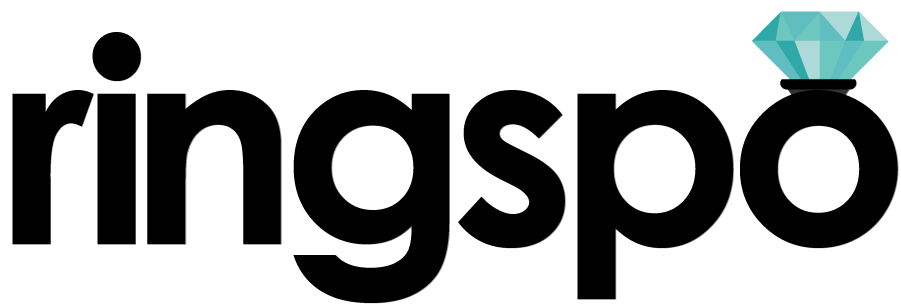DIAMOND CERTIFICATION
Maybe the most important ‘C’ of all
Ringspo is reader supported
Ringspo is reader-supported, which means we may receive a commission if you click a link to a retailer & subsequently make a purchase.
We feature links to several retailers to help readers find the one that is the best fit for them. Find out more about how Ringspo works here.
Certification, certified and certificates are all terms that you’ll find bandied round by jewelers, people talking about diamond and anyone that has done any research at all around diamonds. It’s even sometimes included as the 5th C of diamonds.
So what does it really mean, how important is it and how do you make sure that you get the best ‘certificate’?
What is certification?
Certification is the process of assessing and grading a diamond against predetermined characteristics – the 4Cs of cut, color clarity and carat. Basically putting them through the NFL Scouting combine to see how they measure up.
This process is conducted by independent labs who then issue a ‘grading report’ detailing the 4Cs, which is then used by retailers to work out the price of a stone.
There are many labs across the world that conduct grading reports, but they aren’t all equal. Some have super strict standards, while others are more lax. This is important because you want to make sure that you are getting what you pay for. But more on that later.
Watch out: Grading labs don’t actually ever use the term ‘certificate’. It’s the commonly used term in the jewelry industry, but you’ll never see it written on a report. Instead they will talk about a ‘grading report’ or similar. In this article I’m going to continue to use ‘certificate’ because it is the most commonly used term and it applies across all of the grading labs.
Why is certification so important?
Certification is hugely important for four reasons:
1. Verify it’s the real deal
The first is to make sure that what you are getting is the real deal – a natural diamond and not a lab-grown ‘cultured’ diamond. This is getting more important as advances in the technology for producing lab-grown diamonds means that they can be incredibly difficult to distinguish from the real thing.
In 2011, a large batch of synthetic diamonds entered the diamond supply chain when a dealer, who believed them to be real, sold them on to jewelers. They were so convincing that when examined under a microscope by an experienced jeweler, there was no indication that they weren’t natural diamonds.
The switcheroo only came to light when one of the stones from the batch was examined by a grading lab, who used high-tech photoluminescence equipment to show that they had been grown artificially.
Although incidents like this are rare, it reinforces the importance of ensuring that every diamond you consider has been assessed and verified by a reputable independent lab.
2. Highlight treatments
The second reason that certification is important is because it will verify whether a stone has been treated in any way to improve its appearance. Treatments can be applied to diamonds to improve the colour or clarity of a diamond. It’s very difficult to tell whether stones have had treatment applied to them, but stones that have been subject to them are worth considerably less than natural stones.
Much like the dude who divorced his wife when he found out that she had had a ton of plastic surgery before they met, but then passed her less-than-awesome genes on to their kids, you want to make sure that you are getting the real, and naturally beautiful, deal.
But, if you are happy to buy a treated stone then you can pick up a bargain.

3. Enforces consistency
Certification adds consistency to diamonds and makes your decision making easier. If you are looking at a stone from an online store in the USA and one from a store in the UK and both have been graded by the GIA, you can be assured that they are both the same quality. Even if they were graded in different labs in different countries, this consistency will mean that you can then make your purchase decision on other factors like the price or the quality of service.
However, this consistency of grading only applies within individual organisations. Although the same terminology around the 4Cs is used by different labs, they definitely don’t grade diamonds in the same way, as we’ll see.
4. Gives you confidence
Knowing that the diamond that you are considering has been assessed by an expert should give you great confidence in your purchase. It is the reason why you can safely buy online – any diamond that you are looking at has been graded by someone with years of experience to help you make a considered choice. Rather than being subject to sales spiel or dazzled by the bright lights of a bricks and mortar jewelry store, comparing the grading reports means that you can make an informed decision to get the perfect diamond for your engagement ring at the best possible price.
What is certification not?
Certification doesn’t assign a value to a diamond, although it is used by jewelers to help determine a diamond’s value.
An assessment of a diamond that does assign a value to it is known as an ‘appraisal’ and they’re usually conducted on a piece of jewelry after it has been purchased, often for insurance purposes.
Appraisals do look at some of the same things as certification, but they’re usually conducted by an in-house gemologist at a jeweler rather than an independent lab. While most will undoubtedly be honest and competent, they still won’t be subject to the same standards of consistency and impartiality as a grading lab, so an appraisal should never be seen as a substitute for a certification.
What’s the process?
Grading labs can only grade unset stones ie. those that aren’t in a ring or other piece of jewelry.
If a diamond is already in a setting, it could be removed and graded, but there would be an additional cost for removing the stone and then remounting it, as well as the possibility of damaging the stone in the process. Ideally, you want to make sure that any stone you’re looking at has already been certified before you consider it.
The grading process looks at each of the 4 Cs in turn:
Carat weight
A diamond’s carat weight is measured using a micro balance which measures weight down to 0.0001 grams.
The diamond is then tested with photoluminescence equipment which shows whether it’s a natural or a synthetic diamond and then an optical scanning device is used to record the proportions of the diamond. Learn more about diamond carat weight.
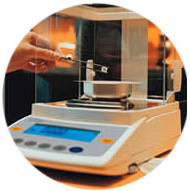
Clarity

Clarity is manually assessed by examining a stone under a 10x microscope, with the grader looking for inclusions and then looking at the ‘finishing’ characteristics – polish and symmetry.
A second grader then independently completes the same assessment. Depending on how different the two reports are, a third and more senior grader may then repeat the process to find the definitive values. Find out more about clarity here.
Color
To determine a diamond’s colour the stone is flipped ‘face down’, as the colors are easier to see in this orientation, and then compared to a set of ‘master stones’. The master stones are a set of 23 diamonds, or cubic zirconia which have been tinted to represent diamond colors, which range from the very whitest (D) to the most yellow (Z) and have been signed off as true representations of each of the color grades.
Again, more than one grader conducts this process to ensure that it is accurate. Learn more about diamond color.

Color grade D

Color grade G

Color grade P

Color grade X
Cut
Cut grade is only applied to round brilliant diamonds and the graders will examine the proportions of the stone and the angles between its facets, checking how closely it relates it the ideal proportions (right).
The graders will also assess the diamond’s level of fire, brilliance and scintillation, which are all measures of how it affects light. They’re basically assessing it to judge how much the stone sparkles.
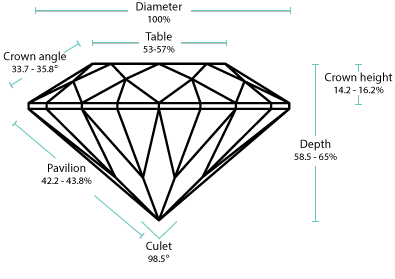
Grading Reports
Full Grading Report
The full grading report includes the dimensions of the stone, the grading of the 4 Cs and any other identifying information in the left hand column.
The center column includes the proportions of the diamond and a plot of all of the ‘clarity characteristics’ ie. the flaws on the stone.
Lastly, the right hand column includes a key to explain the certificate.
Click the image to see it larger.
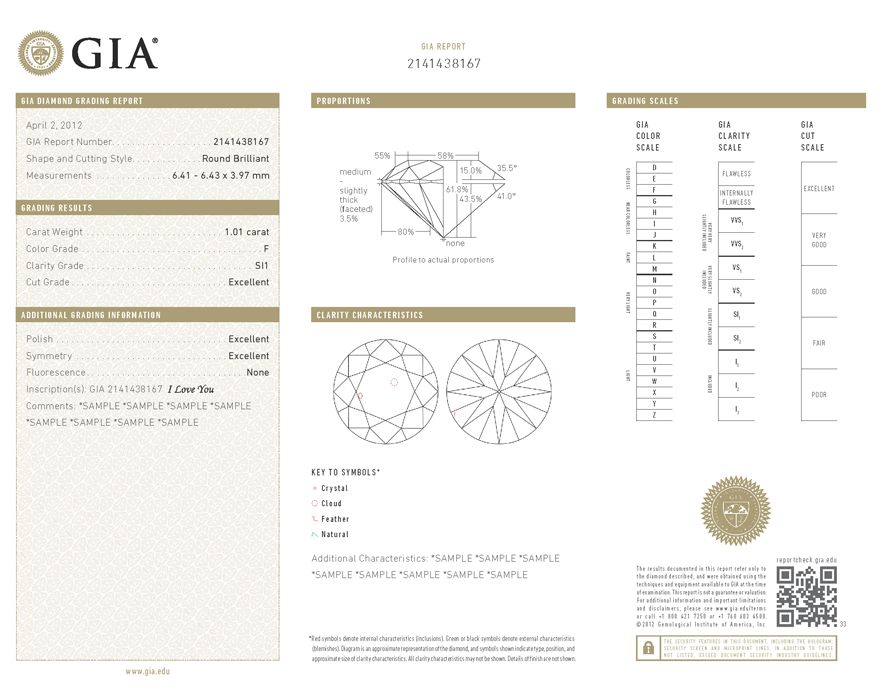
Dossier
A ‘dossier’ is often used for smaller stones. It’s less expensive than the full report for a lab to produce, so it can make more sense to not incur the cost of the producing a full grading report for a less valuable stone.
Although the dossier still includes the dimensions of the stone, the grading of the 4 Cs and any other identifying information and a diagram of the proportions of the diamond, it doesn’t include a plot of the diamond’s inclusions.
Click the image to see it larger.
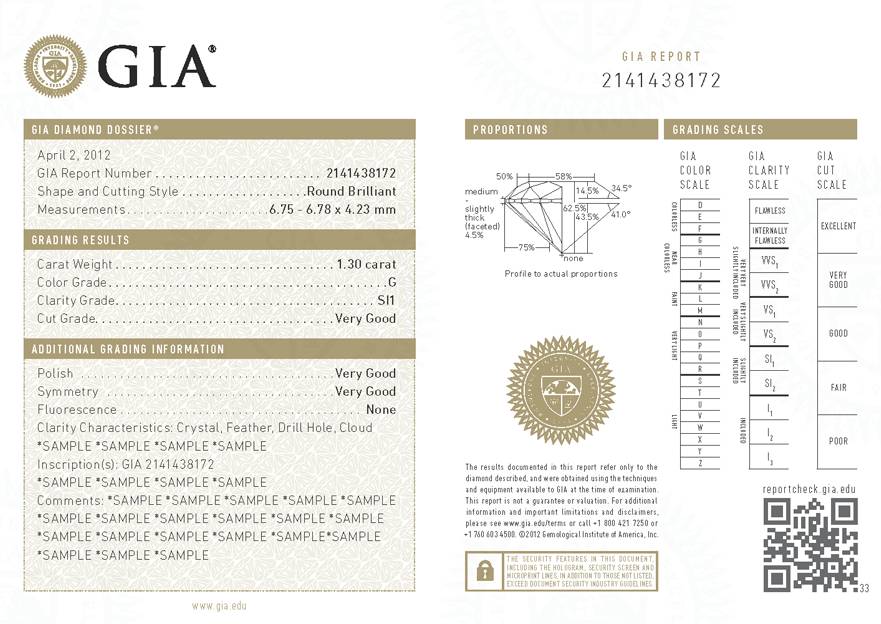
Laser inscribing
When a diamond is issued its report it’s assigned an individual number and some labs will etch this number into the girdle (the rim) of the stone with a laser to pair it to the certificate and allow it to be identified. Reports that the lasers are mounted on sharks’ heads are unconfirmed at this stage.
The number can only be seen when viewed through a microscope, but is great for peace of mind. One of the old fears with diamonds was that they could be swapped out by an unscrupulous jeweler and it would be impossible to tell. Now though, you can ask to examine the number and confirm that it matches the one on your certificate. Phew!

The Grading Labs
Although there are several grading labs out there, they definitely aren’t all equal and there are only a couple that you really want to look for – those that have the best reputations for consistency and honesty.
The Gemological Institute of America (The GIA)
Starting off with the lab with the best reputation, the GIA was established in 1931 and literally wrote the book on diamond grading – they created the 4Cs that have been adapted by every other jewelry grading lab and jeweler out there.
As well as grading diamonds, the GIA places a big focus on education, and it’s not uncommon to see a GIA sticker at the door of most jewelers to show that some of their staff have been through the GIA’s education process – it’s a point of pride.
GIA-graded stones are often priced at a premium over other labs, but that is usually because their grading is the most accurate and correct. I’ll look at about all of the other grading labs in relation to the GIA because they are the standard that others should be judged by. Usually if you are looking at a non-GIA stone, you aren’t paying less for non GIA stones, you’re actually getting less for your money.
American Gem Society (AGS)
The AGS was originally created in 1934 in an effort to create an industry organisation that would protect jewelry buyers and increase the retailer’s reputation for ethical behaviour.
The AGS uses a different scale than the GIA for clarity and color – possibly a more logical scale based on 1-10 for color and clarity.
You can compare the AGS’s clarity scale to the GIA’s:

And the AGS’s color scale is:

However, it’s much more likely that you’ll come across the GIA’s scale for grading diamonds than the AGS’s.
The GIA and the AGS are the two most reputable grading labs and the two that I would recommend. They have the best interests of the consumer in mind, rather than providing overly-generous grading reports which will increase a jeweler’s profits at the expense of the consumer.
European Gemological Laboratory (EGL)
The EGL is different from the GIA and AGS in that it’s a for-profit organisation, which means that it does not have the same incentive for conservative grading and impartiality. They know that if they provide more generous gradings to stones then jewelers will be able to sell them for a higher price. And if stones can be sold for a higher price then the retailers are more likely to send stones to EGL – it’s a self-perpetuating cycle.
Although the EGL uses the same grading scales as the GIA, the gradings that it awards are often drastically different.
A stone may be graded around two grades higher on an EGL certificate than a GIA certificate, so although it might seem like you are getting a good quality stone for a great price, you may actually be paying over the market value and getting less for your money than you would with a stone certified by the GIA.
Why’s this important? Let’s look at the price for a diamond that has been graded by GIA and EGL
- Carat – 1
- Clarity – VS2
- Color – F
Looking at an online retailer, a stone with these characteristics that has been graded by GIA would cost $6,150:

While a stone with the same specs but graded by EGL would cost just $4,960:

A clear saving to be made though, right? You’re getting a stone of equivalent quality for a much lower price.
Not necessarily.
If we knock the two grades off the EGL’s report to get the equivalent GIA grading for that stone, we are looking for a stone with a grading of:
- Carat – 1
- Clarity – SI2
- Color – H
If we look for a stone that matches these specs that has been graded by GIA then the price comes in at just $4,270:

It’s actually cheaper to buy a GIA graded stone to get the same quality.
International Gemological Institute (IGI)
Based in Antwerp, Belgium and probably the second most widespread lab after GIA. The IGI has a similar reputation to EGL for being less conservative and less consistent with its grading reports.
Hoge Van Randstad (HRD)
Again based in Antwerp, HRD is intended to be the European version of the GIA – an impartial authority on diamond grading. It has a good reputation in Europe, but its reputation in the US is similar to the IGI’s – gradings are inconsistent. To be on the safe side I would recommend taking two grades off their grade reports to bring it into line with the GIA.
Buying without certification
If you’re looking at a diamond of any significant size (over 0.5 carat) for use in an engagement ring, then I would recommend always ensuring that it has a grading report from a 3rd party lab – with GIA and AGS being strong preferences.
If a stone doesn’t have a certificate and the jeweler offers to put you in touch with someone who can give an ‘independent’ assessment of it then definitely avoid this. The assessor is very likely to be in cahoots with the retailer and will overestimate the quality of the stone.
It’s not that expensive to get a reputable lab to grade a diamond (around $100), so if anything seems a little fishy of odd then just walk away – there are plenty of other, more reputable retailers out there who will be happy to supply with you a diamond that has been graded by GIA or AGS.
When certification isn’t needed
There are some circumstances where a grading report is not strictly necessary, and that’s where the diamonds used are small.
Small diamonds are used in pave settings, on halo settings and in channel-set bands. Each diamond could be anywhere from 0.005ct to 0.1 carats, and their small size, and the relative low cost of them means that it just doesn’t make sense to grade them, as well as the small size making it very difficult to do so.
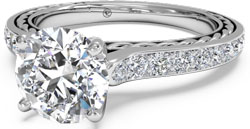
Inclusions are very difficult to see in small stones, the color is difficult to judge and the cut makes much less difference to the amount that a stone sparkles than with larger stones.
What this means is that even if you plump for a top quality center stone for your ring, any side stones may be lower quality. There’s not much you can do to get round this, other than ensuring that all of the stones are taken into account in the appraisal that is conducted after the ring has been purchased.
To sum it all up
There are two big recommendations that you should take away from this page.
The first is a no-brainer – always make sure that any center-stone or sizeable diamond that you’re looking at has a certificate from an independent lab. Don’t ever trust an assessment of a diamond prepared by a jeweler’s in-house gemologist – there’s no incentive for them to not overstate the quality of the stone to increase its sale value.
And the second is that the GIA and the AGS are the certificates to go for. Yes, choosing a certificate from one of the other authorities may make it seem like you are getting a better deal, but its likely that you are actually paying more money for a diamond of lesser quality.
Learn more about the 4Cs

Carat
Find out why biggest isn’t always best

Clarity
How to avoid paying over the odds

Cut
Find out why it’s the most important C

Color
Make sure your choice makes a difference
